MERCEDES-BENZ E-CLASS CABRIOLET 2010 Owner's Guide
Manufacturer: MERCEDES-BENZ, Model Year: 2010, Model line: E-CLASS CABRIOLET, Model: MERCEDES-BENZ E-CLASS CABRIOLET 2010Pages: 333, PDF Size: 7.64 MB
Page 31 of 333
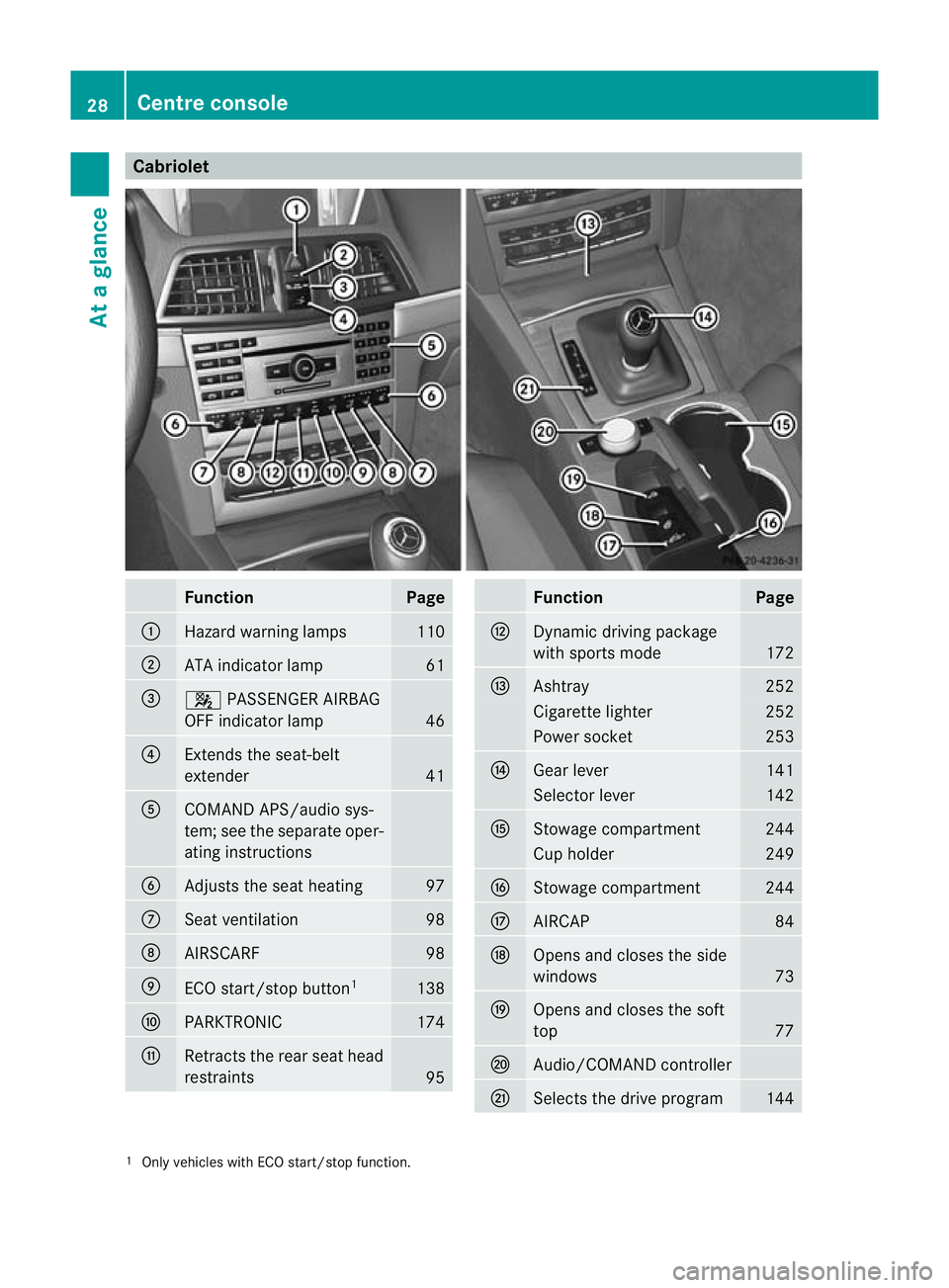
Cabriolet
Function Page
:
Hazard warning lamps 110
;
AT
Ai ndicator lamp 61
=
4
PASSENGER AIRBAG
OFF indicator lamp 46
?
Extend
sthe seat-belt
extender 41
A
COMAND APS/audi
osys-
tem ;see th eseparate oper-
atin ginstructions B
Adjusts the sea
theating 97
C
Seat ventilation 98
D
AIRSC
ARF 98
E
ECO start/stop button
1 138
F
PARKTRONIC 174
G
Retracts the rear seat head
restrain
ts 95 Func
tion Page
H
Dynamic driving package
wit
hsports mode 172
I
Ashtray 252
Cigar
ettelighter 252
Power socket 253
J
Gear lever 141
Selector lever 142
K
Stowage compartment 244
Cup holder 249
L
Stowage compartment 244
M
AIRCAP 84
N
Open
sand closes the side
windows 73
O
Ope
nsand closes the soft
top 77
P
Audio/COMAN
Dcontroller Q
Selec
tsthe driv eprogram 144
1
Only vehicles with ECO start/stop function. 28
Centre consoleAt
ag lance
BA 20 7ECE ÄJ 2010/1a; 1; 2, en-GB
mkalafa Version:3.0.2.11
2010-01-26T13:03:22+01:00
-Seite 28
Page 32 of 333
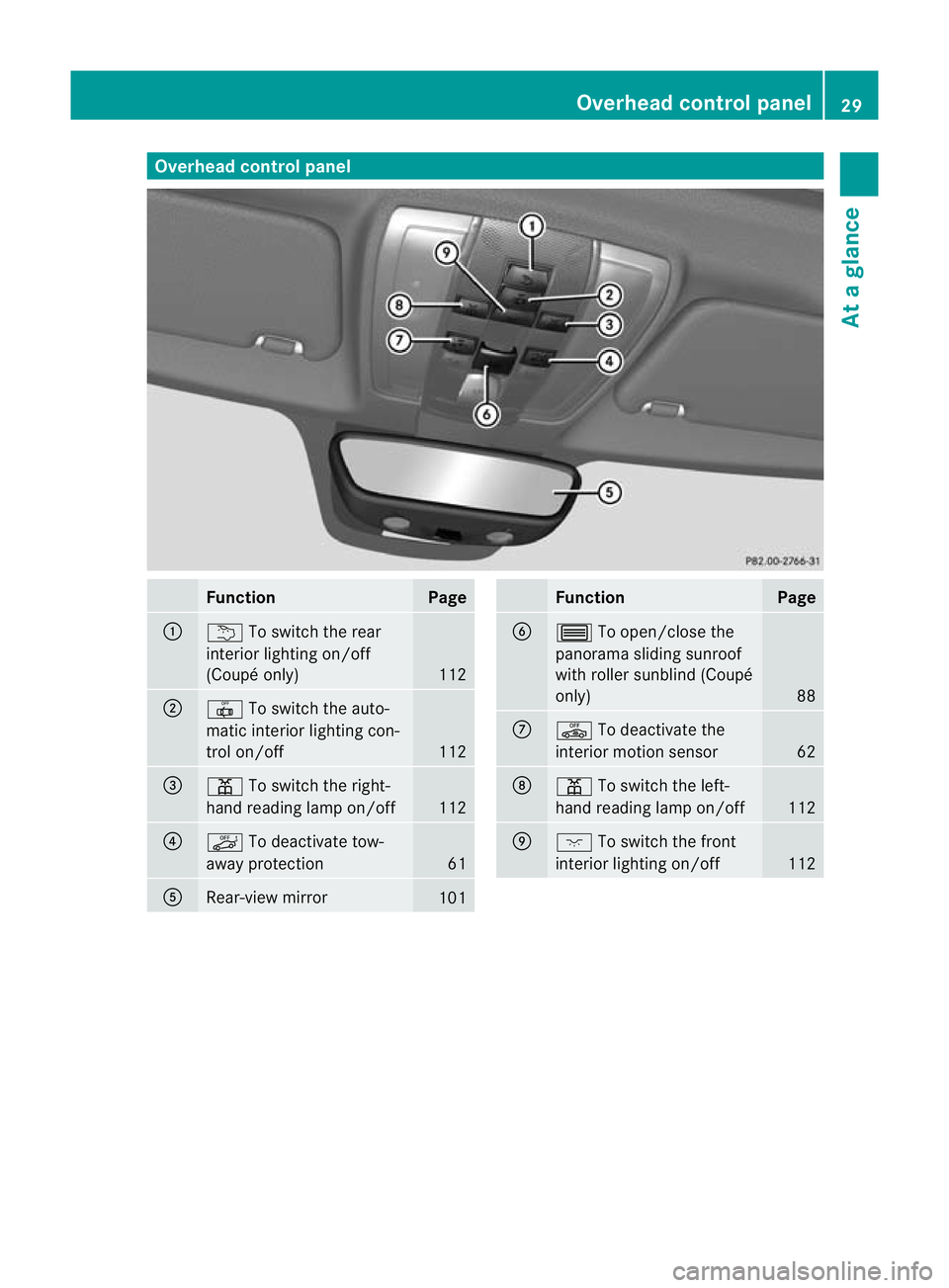
Overhea
dcontrol panel Function Page
:
u
To switch th erear
interio rlightin gon/off
(Coupé only) 112
;
|
To switc hthe auto-
ma tici nterior lighting con-
trol on/off 112
=
p
To switc hthe right-
hand readin glamp on/off 112
?
ë
To deactivat etow-
away protection 61
A
Rear-view mir
ror 101 Function Page
B
3
To open/close the
panorama sliding sunroof
wit hroller sunbli nd(Coupé
only) 88
C
ê
To deactivat ethe
interior motion sensor 62
D
p
To switc hthe lef t-
hand readin glamp on/off 112
E
c
To switc hthe fr ont
interi or lighting on/off 112Overhead control panel
29Atag lance
BA 20 7ECE ÄJ 2010/1a; 1; 2, en-GB
mkalafa Version: 3.0.2.11 2010-01-26T13:03:22+01:00-Seite29
Page 33 of 333
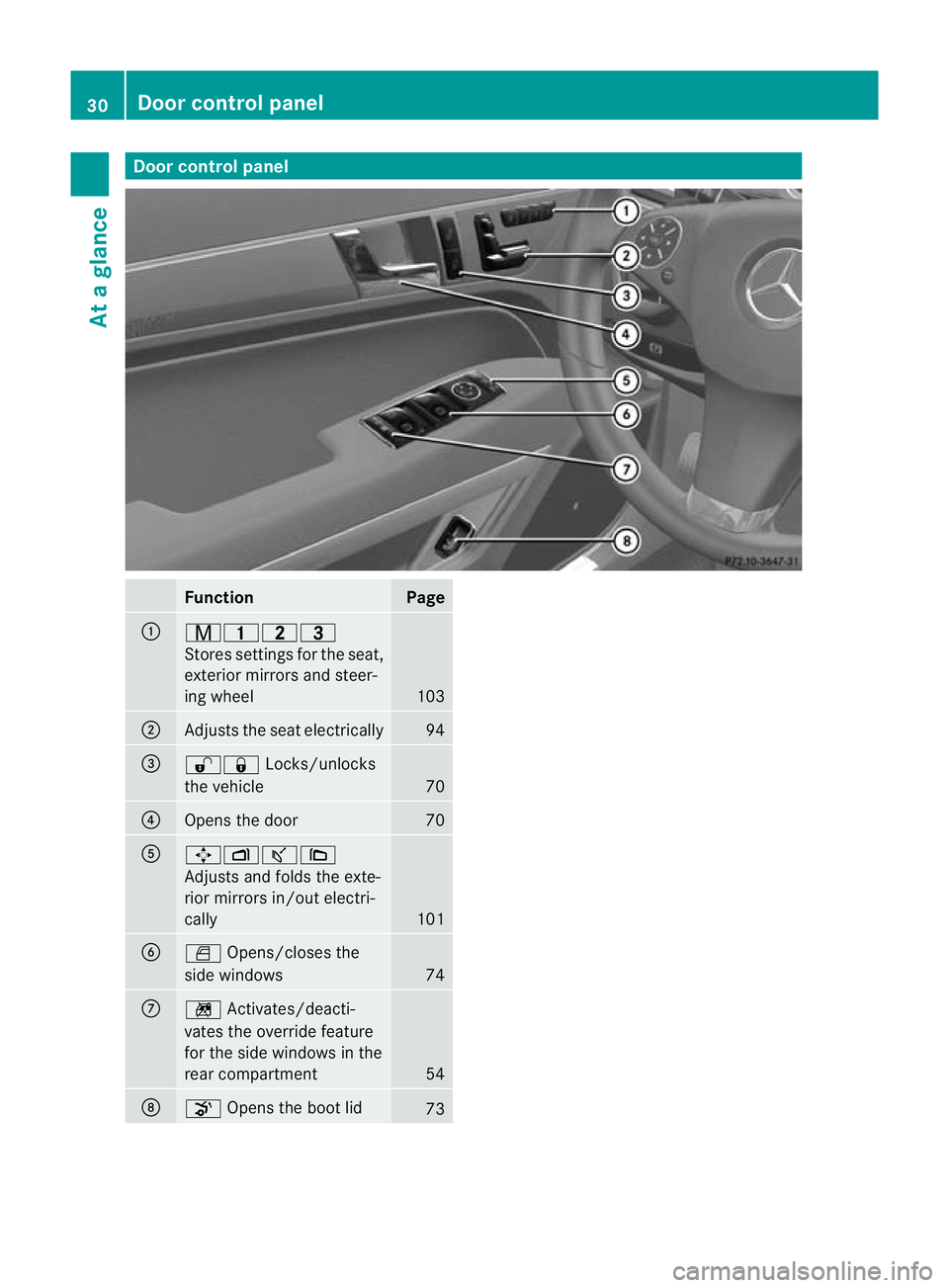
Door control panel
Function Page
:
r4
5=
Stores se ttingsfor the seat,
exterior mirrors and steer-
ing wheel 103
;
Adjusts the seat electrically 94
=
%&
Locks/unlocks
the vehicle 70
?
Opens the door 70
A
7Zª\
Adjusts and folds the exte-
rior mirrors in/out electri-
cally
101
B
W
Opens/closes the
side windows 74
C
n
Activates/deacti-
vates the override feature
for the side windows in the
rear compartment 54
D
o
Opens the boot lid 7330
Doo
rcontrol panelAt ag lance
BA 20 7ECE ÄJ 2010/1a; 1; 2, en-GB
mkalaf aV ersion: 3.0.2.11
2010-01-26T13:03:22+01:00
-Seite 30
Page 34 of 333
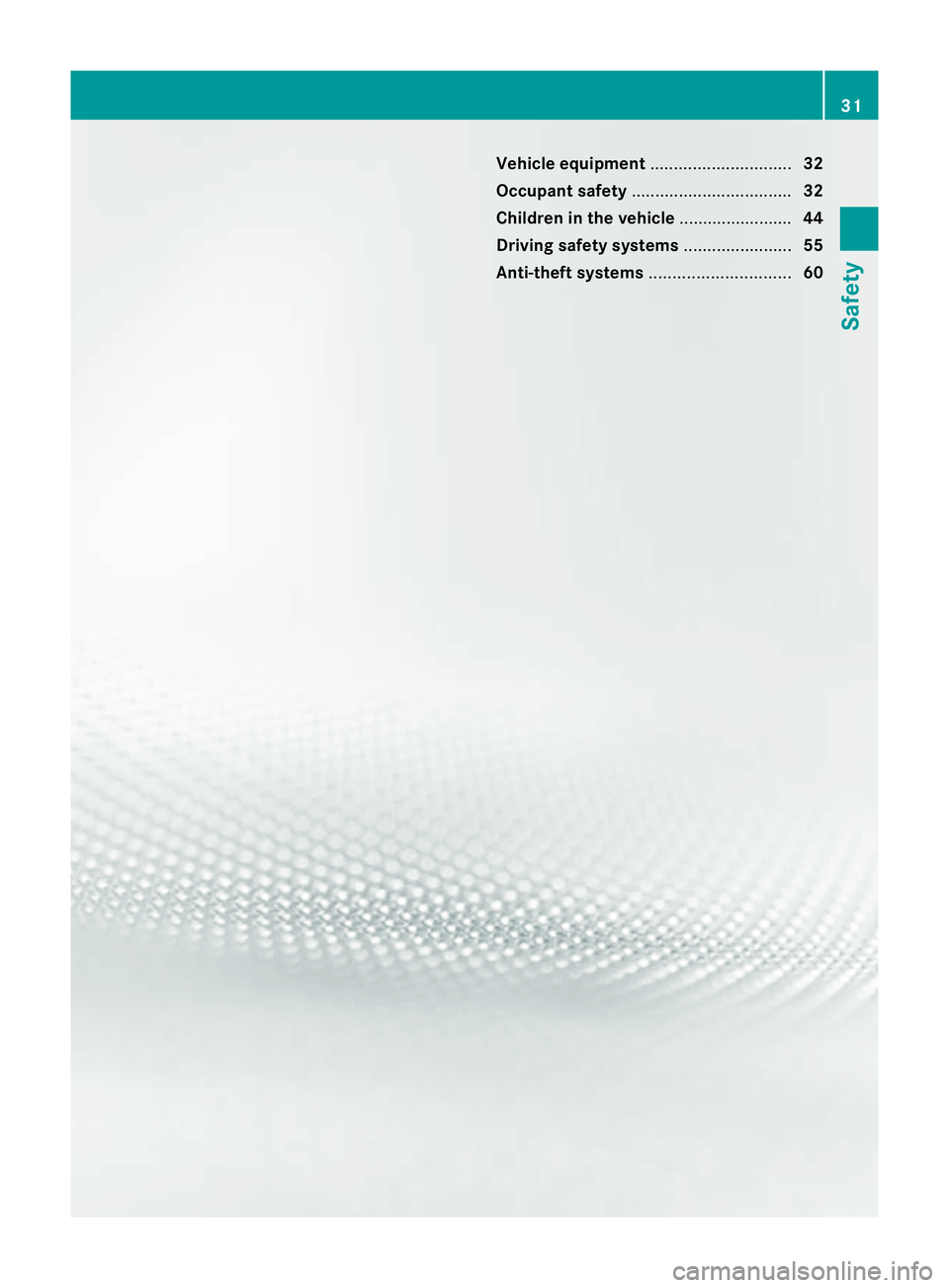
Vehicl
eequipment .............................. 32
Occupant safety .................................. 32
Child renint he vehicle ........................ 44
Driving safety systems .......................55
Anti- theft systems .............................. 60 31Safety
BA 20
7ECE ÄJ 2010/1a; 1; 2, en-GB
mkalafa Version:3.0.2.11
2010-01-26T13:03:22+01:0
0-Seite 31
Page 35 of 333
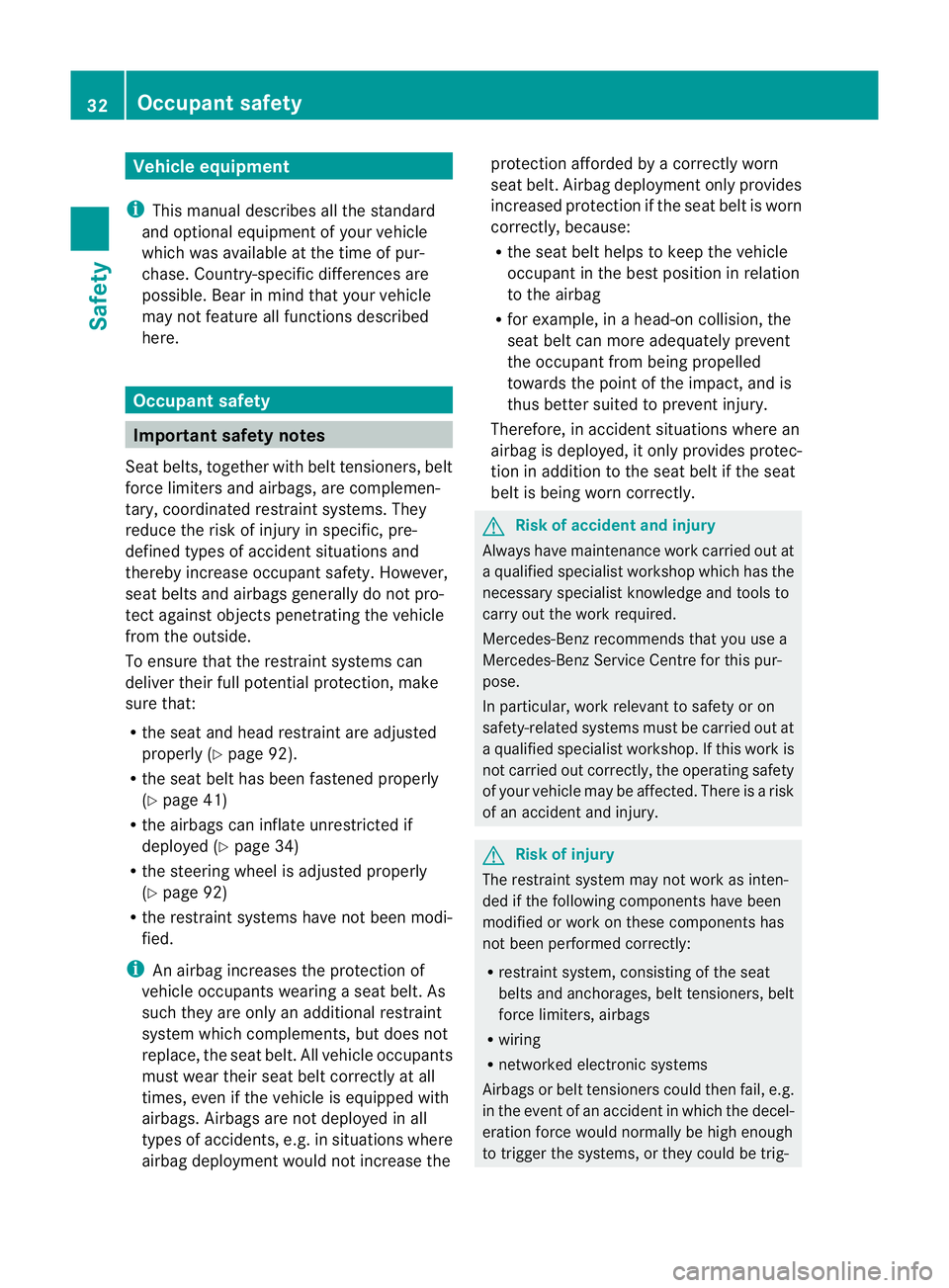
Vehicl
eequipment
i Thismanua ldesc ribe sallthe standard
and optional equipment of your vehicle
which wa savailable at th etime of pur-
chase. Countr y-specif ic differences are
possible. Bear in mind tha tyour vehicle
ma ynot featur eall function sdescribed
here. Occupant safety
Important safet
ynotes
Seat belts, together with belt tensioners, belt
forc elimiter sand airbags, are complemen-
tary, coordi nated restraint systems. They
reduce the risk of injur yinspecific ,pre-
define dtypes of accident situa tions and
thereby increase occupan tsafety. However,
seat belts and airbags generally do not pro-
tec tagainst objec tspenetratin gthe vehicle
from the outside.
To ensur ethat the restraint system scan
deliver their full potential protection, make
sure that:
R the seat and head restraint are adjusted
properly (Y page 92).
R the seat belt has been fastened properly
(Y page 41)
R the airbags can inflate unrestricted if
deployed (Y page 34)
R the steering wheel is adjusted properly
(Y page 92)
R the restraint systems have not been modi-
fied.
i An airbag increases the protection of
vehicle occupant swearing aseat belt. As
such they are only an additional restraint
system which complemen ts,b ut does not
replace, the seat belt. All vehicle occupants
must wear their seat belt correctly at all
times, even if the vehicle is equipped with
airbags. Airbags are not deployed in all
types of accidents, e.g. in situations where
airbag deployment would not increase the protection afforded by
acorrectly worn
seat belt. Airbag deployment only provides
increased protection if the seat belt is worn
correctly, because:
R the seat belt helps to keep the vehicle
occupan tinthe best position in relation
to the airbag
R for example, in ahead-on collision ,the
seat belt can mor eadequately prevent
the occupant from being propelled
towards the point of the impact, and is
thus better suited to prevent injury.
Therefore, in accident situations where an
airba gisd eployed, it only provides protec-
tion in addition to the seat belt if the seat
belt is being worn correctly. G
Risk of accident and inju
ry
Always have maintenance work carried out at
aq ualified specialist workshop which has the
necessary specialist knowledg eand tool sto
carry out the work required.
Mercedes-Benz recommends that you use a
Mercedes-Benz Service Centre for thi spur-
pose.
In particular, work relevant to safety or on
safety-related systems must be carried out at
aq ualified specialist workshop .Ifthis wor kis
not carried out correctly, the operating safety
of your vehicl emay be affected. There is arisk
of an accident and injury. G
Risk of injury
The restrain tsystem may not work as inten-
ded if the following components have been
modified or work on thes ecomponents has
not been performed correctly:
R restraint system ,consisting of the seat
belts and anchorages, belt tensioners, belt
force limiters, airbags
R wiring
R networked electronic systems
Airbags or belt tensioners coul dthen fail, e.g.
in the even tofanaccident in which the decel-
eratio nforc ew ould normally be high enough
to trigger the systems, or they coul dbetrig- 32
Occupant safetySafety
BA 207 ECE ÄJ 2010/1a; 1; 2, en-GB
mkalafa
Version: 3.0.2.11 2010-01-26T13:03:22+01:00-Seite 32
Page 36 of 333
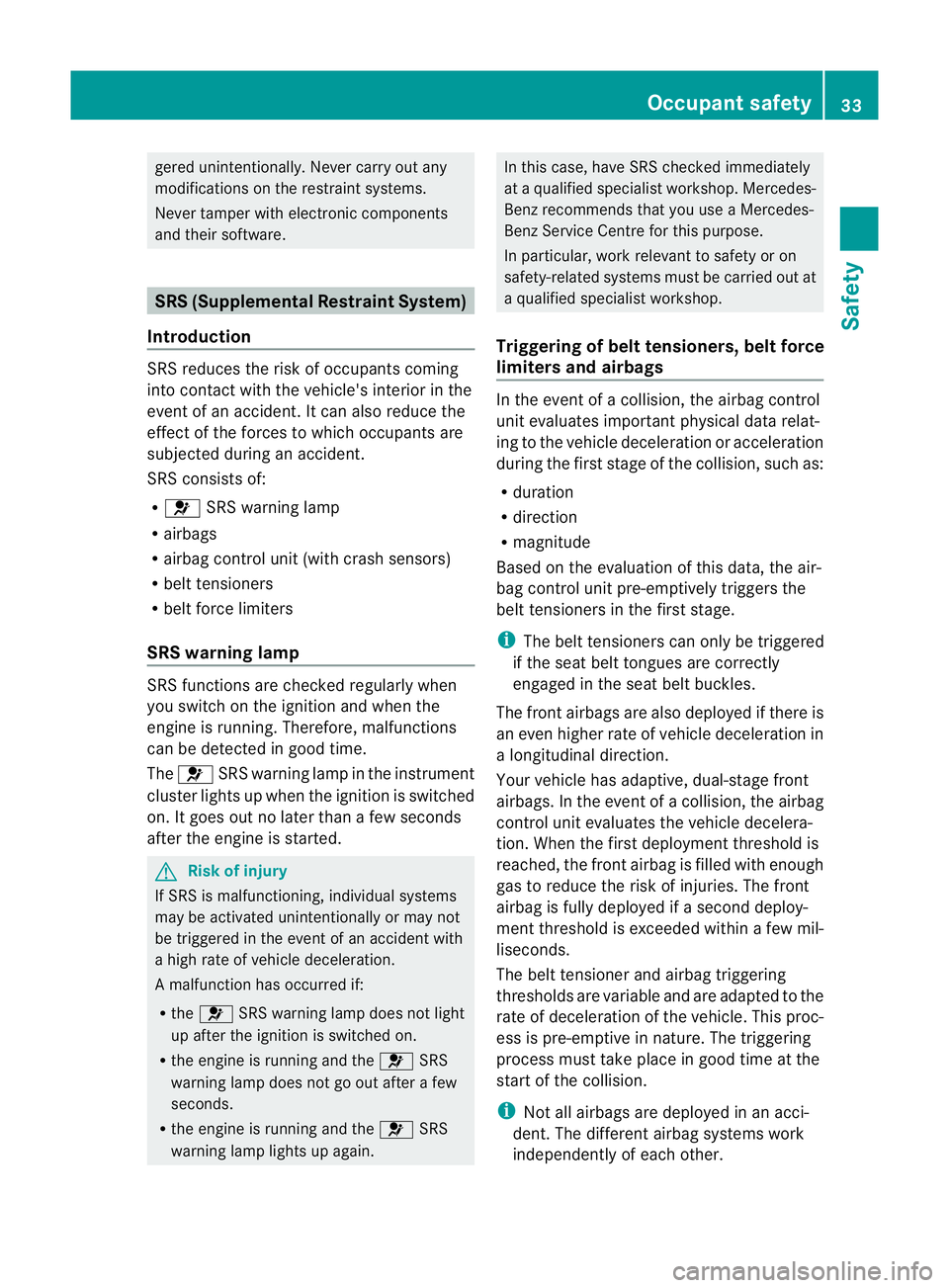
gered unintentionally
.Never carry out any
modifications on the restraint systems.
Never tamper with electronic components
and their software. SRS (Supplemental Restraint System)
Introd uction SRS reduces the risk of occupants coming
into contact with the vehicle's interio
rinthe
even tofana ccident. It can als oreduce the
effect of the forces to which occupant sare
subjected during an accident.
SRS consists of:
R 6 SRS warning lamp
R airbags
R airbag con trol unit (with crash sensors)
R belt tensioners
R belt force limiters
SRS warning lamp SRS func
tions ar echecked regularly when
you switc honthe ignition and when the
engin eisrunning. Therefore, malfunctions
can be detected in good time.
The 6 SRS warning lamp in the instrument
cluster lights up when the ignition is switched
on. It goes out no later than afew seconds
after the engine is star ted. G
Risk of inju
ry
If SR Sism alfunctioning, individual systems
may be activated unintentionally or may not
be triggered in the event of an accident with
ah igh rate of vehicle deceleration.
Am alfunction has occurred if:
R the 6 SRS warning lamp does not light
up after the ignition is switched on.
R the engine is runnin gand the 6SRS
warning lamp doe snot go out after afew
seconds.
R the engine is runnin gand the 6SRS
warning lamp lights up again. In this case, have SRS checked immediately
at
aq ualified specialist workshop .Mercedes-
Benz recommends that you use aMercedes-
Benz Servic eCentr efor this purpose.
In particular ,work relevant to safet yoron
safety-related systems must be carried out at
aq ualified specialist workshop.
Triggering of belt tensioners, belt force
limiters and airbags In the event of
acollision ,the airbag con trol
unit evaluates important physical data relat-
ing to the vehicle deceleration or acceleration
during the first stage of the collision, such as:
R duration
R direction
R magnitude
Based on the evaluation of this data ,the air-
bag con trol unit pre-emptivel ytriggers the
belt tensioners in th efirst stage.
i The belt tensioners can only be triggered
if the seat belt tongues are correctly
engaged in the seat belt buckles.
The front airbags are also deployed if there is
an even higher rate of vehicle deceleration in
al ongitudinal direction.
Your vehicle has adaptive, dual-stage front
airbags. In the even tofacollision, the airbag
control unit evalu atesthe vehicle decelera-
tion. Whe nthe first deploymen tthreshol dis
reached, th efront airbag is fille dwith enough
gas to reduce the risk of injuries. The front
airbag is fully deployed if asecon ddeploy-
men tthreshold is exceeded withi nafew mil-
liseconds.
Th eb elt tensioner and airbag triggering
thresholds are variable and are adapted to the
rat eofd eceleration of the vehicle. This proc-
ess is pre-emptiv einnature. The triggering
process must take place in good time at the
start of the collision.
i Not all airbags are deployed in an acci-
dent. The different airbag systems work
independently of each other. Occupant safety
33Safety
BA 207ECE ÄJ 2010 /1a;1;2,e n-GB
mkalafa Version: 3.0.2.11 2010-01-26T13:03:22+01:00-Seite 33 Z
Page 37 of 333
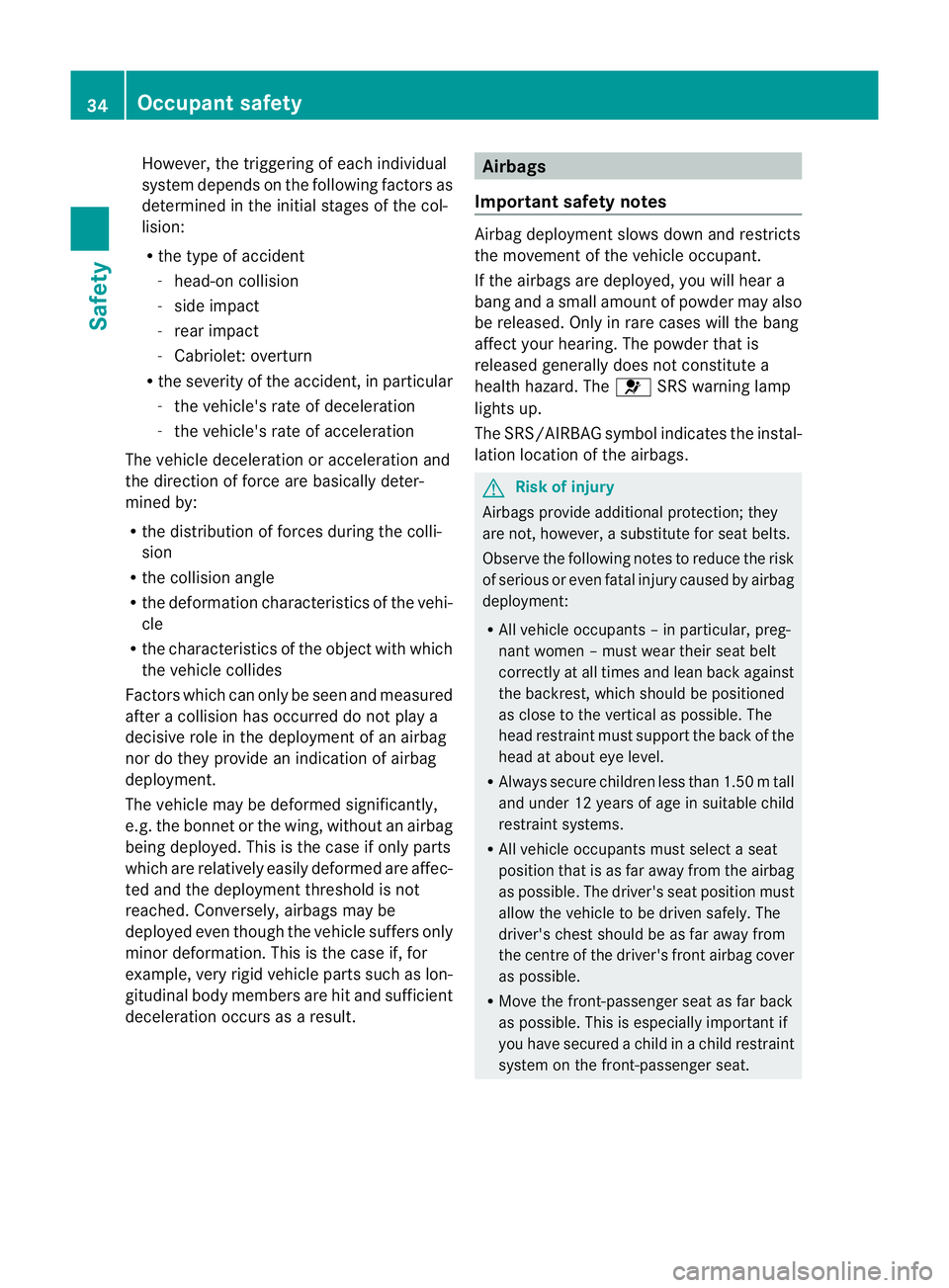
However, the trig
gering of each ind ividual
system depends on the following factors as
determined in the initial stages of the col-
lision:
R the type of accident
- head-on collision
- sid eimpact
- rea rimpact
- Cabriolet: overturn
R thes everity of the accident, in particular
- the vehicle's rat eofdeceleration
- the vehicle's rat eofacceleration
Th ev ehicle deceleration or acceleration and
the direction of force ar ebasicall ydeter-
min edby:
R the distri bution of force sduring the colli-
sion
R the collision angle
R the deform ation characteristics of the vehi-
cle
R the characteristics of the object with which
the vehicle collides
Factors which can only be see nand measured
after acollision has occ urreddon ot play a
decisive role in the deployment of an airbag
nor do they provid eanindicatio nofairbag
deployment.
The vehicle may be deformed significantly,
e.g. the bonnet or the wing, withou tanairbag
being deployed. This is the case if only parts
which are relatively easily deformed are affec-
ted and the deploymen tthreshol disnot
reached. Conversely ,airbags may be
deployed even though the vehicle suffer sonly
minor deformation. Thi sisthe case if, for
example, ver yrigid vehicle parts such as lon-
gitudinal body member sare hi tand sufficient
deceleratio noccurs as aresult. Airbags
Important safety notes Airbag deployment slows down and restricts
the movemen
tofthe vehicle occupant.
If the airbags ar edeployed, you will hear a
bang and asmall amount of powder may also
be released. Only in rare cases will th ebang
affect your hearing. The powde rthat is
released generally does not constitute a
healt hhazard. The 6SRS warning lamp
lights up.
The SRS/AIRBAG symbol indicates the instal-
lation location of the airbags. G
Risk of injury
Airbags provide additional protection; they
are not, however, asubstitute for seat belts.
Observe the following notes to reduce the risk
of serious or even fatal injury caused by airbag
deployment:
R All vehicle occupants –inparticular ,preg-
nant women –must wear their seat belt
correctly at all times and lean back against
the backrest, which should be posi tioned
as close to th evertical as possible. The
head restraint must support th eback of the
head at about eye level.
R Always secur echildren less than 1.50 mtall
and under 12 years of age in suitable child
restraint systems.
R All vehicle occupant smust select aseat
position that is as far away from the airbag
as possible. The driver' sseat position must
allow the vehicle to be driven safely .The
driver's chest should be as fa raway from
the centre of the driver' sfront airba gcover
as possible.
R Move the fr ont-passengers eat as far back
as possible. This is especially impor tantif
you have secured achild in achild rest raint
system on the front-passenger seat. 34
Occupant safetySafety
BA 207 ECE ÄJ 201
0/1a; 1; 2, en-GB
mkalafa Version: 3.0.2.11 2010-01-26T13:03:22+01:00-Seite 34
Page 38 of 333
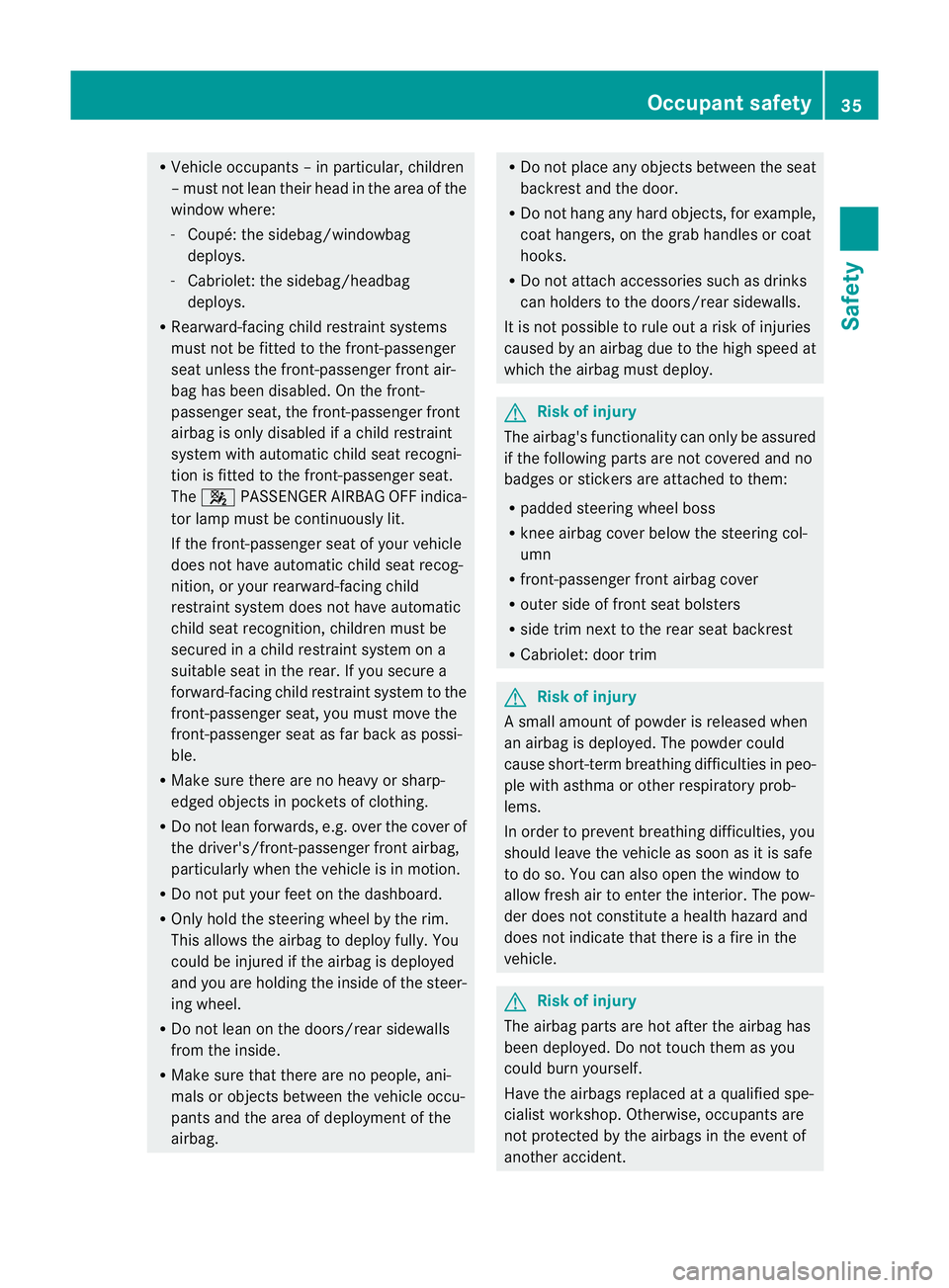
R
Vehicl eoccupant s–inparticular ,children
–m ust not lean their head in the area of the
window where:
- Coupé: the sidebag/windowbag
deploys.
- Cabriolet: the sidebag/headbag
deploys.
R Rearward-facin gchild rest raint systems
must not be fitted to the front-passenger
seat unless the front-passenger fron tair-
bag has been disabled. On the front-
passenger seat, the front-passenger front
airbag is onl ydisabled if achild restraint
system with automatic chil dseat recogni-
tion is fitted to the front-passenger seat.
The 4 PASSENGER AIRBA GOFF indica-
tor lamp must be continuou slyl it.
If the front-passenge rseat of your vehicle
does not have automati cchild seat recog-
nition, or your rearward-facin gchild
rest raint system does not have automatic
child seat recognition, children must be
secured in achild rest raint system on a
suitable seat in the rear. If you secure a
forward-facin gchild rest raint system to the
front-passenger seat, you must move the
front-passenger seat as far back as possi-
ble.
R Make sure there are no heavy or sharp-
edged objects in pockets of clothing.
R Do not lean forwards, e.g. over the cover of
the driver's/front-passenger fron tairbag,
particularly when the vehicle is in motion.
R Do not put your feet on the dashboard.
R Only hold the steerin gwheel by the rim.
This allow sthe airbag to deploy fully. You
coul dbei njured if the airbag is deployed
and you are holding the inside of the steer-
ing wheel.
R Do not lean on the doors/rear sidewalls
from the inside.
R Make sure that there are no people, ani-
mals or obje ctsb etween the vehicle occu-
pants and the area of deployment of the
airbag. R
Do not place any objects between the seat
back rest and the door.
R Do not hang any har dobjects, for example,
coat hangers, on the grab handles or coat
hooks.
R Do not atta chaccessories such as drinks
can holders to the doors/rear sidewalls.
It is not possible to rule out arisk of injuries
caused by an airbag due to the high speed at
which the airbag must deploy. G
Risk of injury
The airbag' sfunctionality can only be assured
if the following parts are not covered and no
badge sorstickers are attached to them:
R padded steerin gwheel boss
R knee airbag cover below the steerin gcol-
umn
R front-passenger fron tairbag cover
R outer side of fron tseat bolsters
R side tri mnexttot he rea rseat back rest
R Cabriolet :door trim G
Risk of inju
ry
As mall amo untofp owder is released when
an air bagisd eployed. The powder could
cause short-term breathing difficulties in peo-
ple with asthma or other respirator yprob-
lems.
In order to prevent bre athing difficulties ,you
should leave the vehicle as soon as it is safe
to do so. You can also open the window to
allow fresh air to enter the interior .The pow-
der does not constitute ahealth hazar dand
doe snot indicat ethat ther eisaf ire in the
vehicle. G
Risk of injury
The airbag parts are hot after the airbag has
been deployed. Do not touch them as you
could burn yourself.
Have the airbags replaced at aqualified spe-
cialist workshop .Otherwise, occupants are
not protected by the airbags in the event of
another accident. Occupant safety
35Safety
BA 207 ECE ÄJ 2010/1a; 1; 2, en-GB
mkalafa Version:3.0.2.11
2010-01-26T13:03:22+01:00
-Seite 35 Z
Page 39 of 333
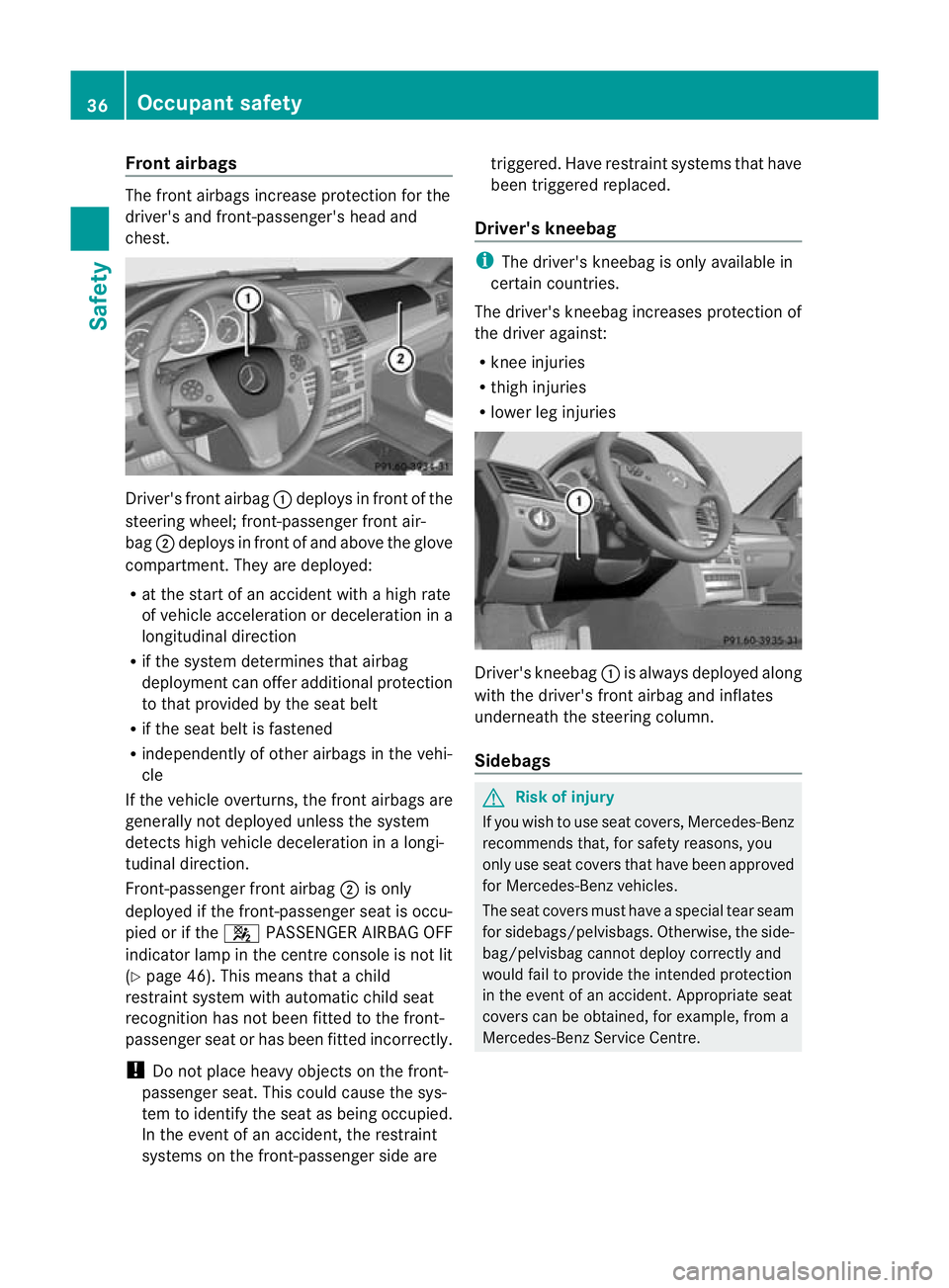
Fron
tairbags The fron
tairbags increase protection for the
driver' sand front-passenger' shead and
chest. Driver
's front air bag:deploys in front of the
steerin gwheel; front-passenger front air-
bag ;deploys in front of and above the glove
compartment .They ar edeployed:
R at the star tofanaccident with ahigh rate
of vehicle acceleration or deceleration in a
longitudinal dire ction
R if the system determines that airbag
deploymen tcan offer additional protec tion
to that provide dbytheseat belt
R if th eseat belt is fastened
R independently of other airbag sinthe vehi-
cle
If the vehicle overturns ,the front airbags are
generally not deployed unless the system
detec tshigh vehicle deceleration in alongi-
tudinal direction.
Front-passenger front airbag ;is only
deployed if the front-passenger seat is occu-
pied or if the 4PASSENGER AIRBA GOFF
indicato rlamp in the centre console is not lit
(Y page 46). This means that achild
restraint system with automatic chil dseat
recognition has not been fitted to the front-
passenger seat or has been fitted incorrectly.
! Do not place heavy object sonthe front-
passenger seat. This could cause the sys-
tem to identify the seat as being occupied.
In the even tofanaccident, the restraint
systems on the front-passenger sid eare triggered
.Have restraint systems that have
been triggered replaced.
Driver's kneebag i
The driver' skneebag is only available in
certain countries.
The driver's kneebag increases protection of
the driver against:
R knee injuries
R thig hinjuries
R lowe rleg injuries Driver's kneebag
:is always deployed along
with the driver' sfront airbag and inflates
underneath th esteering column.
Sidebags G
Risk of injury
If you wish to use seat covers, Mercedes-Benz
recommends that, for safety reasons ,you
only use seat covers that have been approved
for Mercedes-Ben zvehicles.
The seat cover smust have aspecial tear seam
for sidebags/pelvisbags. Otherwise, the side-
bag/pelvisbag cannot deploy correctly and
would fail to provide the intended protection
in the event of an accident. Appropriate seat
cover scan be obtained, for example, from a
Mercedes-Benz Service Centre. 36
Occupant safetySafety
BA 207 ECE ÄJ 201
0/1a; 1; 2, en-GB
mkalafa Version: 3.0.2.11 2010-01-26T13:03:22+01:00-Seite 36
Page 40 of 333
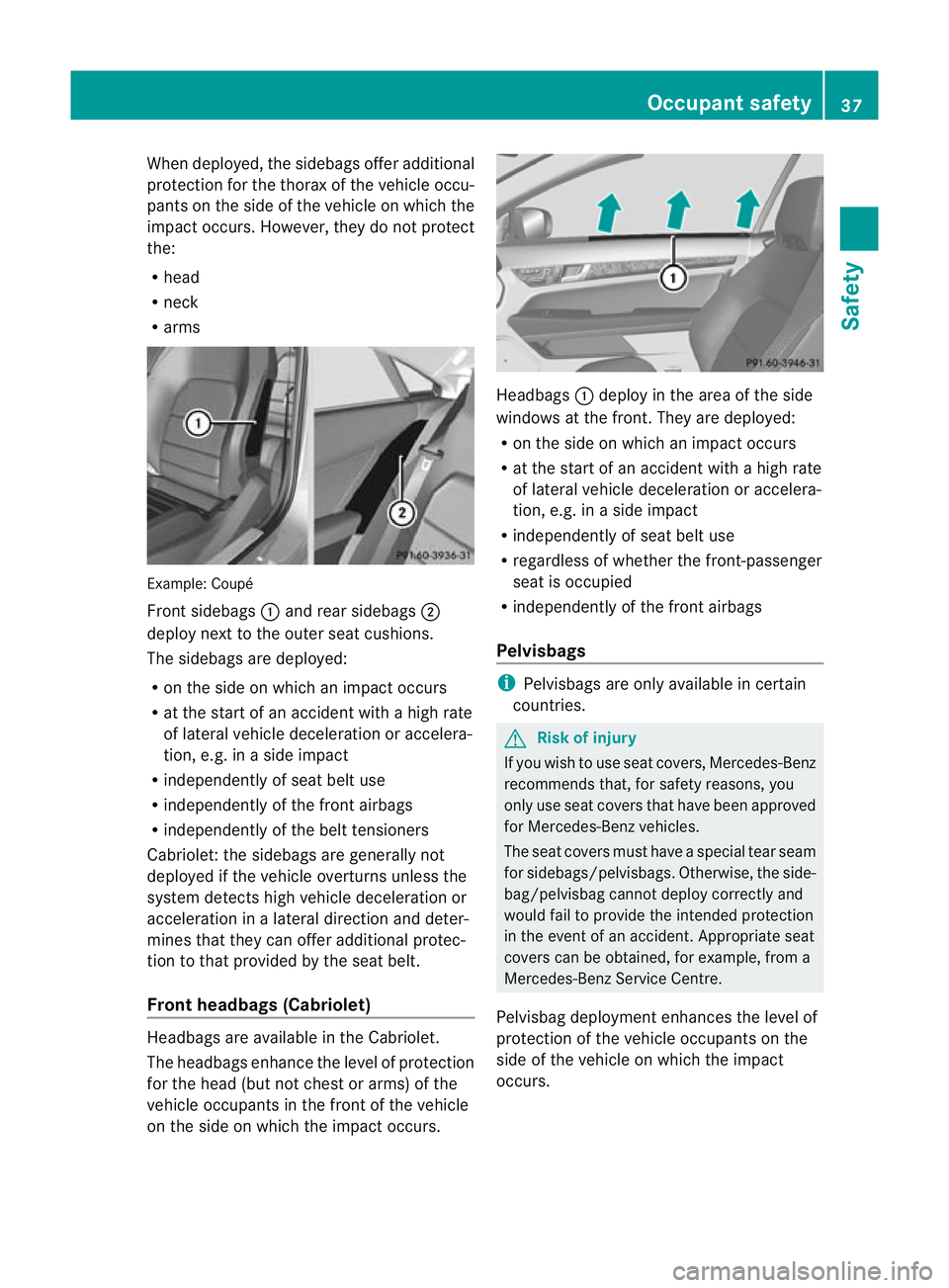
When deployed, the sidebags offer additional
protection for the thorax of the vehicle occu-
pant sont he side of the vehicle on whic hthe
impac toccurs. However, the ydonot protect
the:
R head
R neck
R arms Example: Coupé
Fron
tsidebags :and rear sidebags ;
deploy nex ttothe outer seat cushions.
The sidebags ar edeployed:
R on the side on which an impact occurs
R at the star tofanaccident with ahigh rate
of lateral vehicle deceleration or accelera-
tion, e.g. in aside impact
R independently of seat belt use
R independently of the front airbags
R independently of the belt tensioners
Cabriolet: the sidebags are generally not
deployed if the vehicle overturn sunles sthe
system detec tshigh vehicle deceleration or
acceleration in alateral direction and deter-
mines that they can offer additional protec-
tion to that provided by the seat belt.
Front headbags (Cabriolet) Headbags are available in the Cabriolet.
The headbags enhanc
ethe level of protection
for the head (but not chest or arms) of the
vehicle occupan tsin the front of the vehicle
on the side on which the impact occurs. Headbags
:deploy in the area of the side
windows at the front .They ar edeployed:
R on the side on which an impact occurs
R at the star tofanaccident with ahigh rate
of lateral vehicle deceleration or accelera-
tion, e.g. in aside impact
R independently of seat belt use
R regardless of whether the front-passenger
seat is occupied
R independently of the front airbags
Pelvisbags i
Pelvisbags are only available in certain
countries. G
Risk of injury
If you wish to use seat covers, Mercedes-Benz
recommends that, for safety reasons, you
only use seat cover sthat hav ebeen approved
for Mercedes-Ben zvehicles.
The seat cover smust have aspecial tear seam
for sidebags/pelvisbags. Otherwise, the side-
bag/pelvisbag cannot deploy correctly and
would fail to provide the intended protection
in the event of an accident. Appropriate seat
cover scan be obtained, for example, from a
Mercedes-Benz Service Centre.
Pelvisbag deployment enhances the level of
protection of the vehicle occupant sonthe
side of the vehicle on whic hthe impact
occur s. Occupant safety
37Safety
BA 207ECE ÄJ 2010/1a; 1; 2, en-GB
mkalafa Version: 3.0.2.11 2010-01-26T13:03:22+01:00-Seite 37 Z